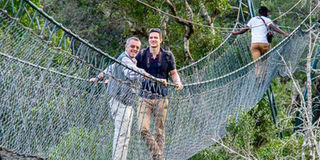Tree top nature trail on hanging bridge

For just Kshs. 3,000 per person on the weekend of the marathon (25th and 26th June), runners and spectators will be transported to the Ngare Ndare Forest and given the opportunity to experience the canopy walk, a 7km guided walk through the forest and a visit to the waterfall. PHOTO | COURTESY
What you need to know:
- Lewa also offers the opportunity for people to spectate – and there’s plenty to do beyond watching the race and viewing the conservancy’s wildlife. The Northern Rangelands Trust (NRT) and the Ngare Ndare community will be offering trips for both spectators and runners to the neighbouring Ngare Ndare Community Conservancy.
- The Safaricom Lewa Marathon has supported NRT, and specifically the Ngare Ndare Conservancy, for a number of years, with proceeds going towards the conservancy’s operating costs and a variety of community projects.
As a keen runner, I was disappointed to find out that registration for this year’s Safaricom Lewa Marathon had filled up in a matter of hours back in February. Though space is understandably limited, it’s an indication of the event’s growing popularity, and its success as a unique fundraising mechanism for the Tusk Trust and Lewa’s community development and conservation initiatives.
Those who have been lucky enough to experience a walking safari will know that there is nothing quite like viewing wildlife on foot. You’re fully immersed in the sights and sounds (and smells) of the bush, without the disconnect of a vehicle. So I completely understand the event’s popularity: it may be one of the world’s toughest marathons, but it’s easily one of its most scenic.
As was highlighted in last week’s Going Places, Lewa also offers the opportunity for people to spectate – and there’s plenty to do beyond watching the race and viewing the conservancy’s wildlife. The Northern Rangelands Trust (NRT) and the Ngare Ndare community will be offering trips for both spectators and runners to the neighbouring Ngare Ndare Community Conservancy – the 5,540 hectare remnants of a vast indigenous forest that once cloaked the foothills of Mount Kenya.
SUSTAINABLE ALTERNATIVES
The forest is one of 33 community-owned and managed conservancies across north-central and eastern Kenya that fall under the NRT umbrella – a system that brings together local, predominantly pastoralist, communities with land owners and the government to promote the long-term conservation of wildlife.
NRT assists the conservancies to design and implement community conservation initiatives, and to improve livestock and water management programmes. As with the Lewa Wildlife Conservancy, the Trust adopts a development-centric conservation model, promoting income diversification for communities through eco-tourism and other nature-based enterprises.
The Safaricom Lewa Marathon has supported NRT, and specifically the Ngare Ndare Conservancy, for a number of years, with proceeds going towards the conservancy’s operating costs and a variety of community projects. The forest is currently managed by the Ngare Ndare Forest Trust – a collaboration of six surrounding communities, and four farms and conservancies – under the supervision of the Kenya Forest Service.
Surrounding communities have grazed and watered their cattle in the forest for decades, but population increases have put a strain on the forest’s resources. To alleviate this pressure, the Ngare Ndare Forest Trust has put in place a number of initiatives to provide sustainable alternatives for these communities. More than 1.5 million gum trees have been planted. And to reduce the reliance on livestock, some community members have been given bee hives to set up in the forest, so that they can sell honey and keep the profits.
The Trust also funds its community development projects with the majority of the income generated from various eco-tourism initiatives, including a 450 metre long, 40ft high wire-mesh walkway through the forest canopy – the only one of its kind in East Africa. This impressive feat of engineering provides a bird’s-eye-view of the forest, amongst huge Strangler Fig, African Olive and Red Cedar trees – some thought to be around 200 years old.
The canopy walk leads to an elevated platform, which provides a great vantage point to view the forest’s prolific birdlife, the occasional herd of elephants, or any of the ‘Big Five’ for that matter. The forest was incorporated into the Mount Kenya World Heritage Site in 2013, after being reconnected to the mountain forests via the ‘elephant underpass’ in 2011.
CANOPY WALK
So the Ngare Ndare Community Conservancy now serves as a vital corridor between Mount Kenya and the Lewa Wildlife Conservancy – and therefore links the mountain to the greater Laikipia-Samburu ecosystem.
Aside from the canopy walk, the forest is also renowned for its striking ‘Blue Pools’. Groundwater from Mount Kenya seeps through and emerges with an alluring turquoise tint – especially in the dry season when this is the only water flowing into the pools. It’s an idyllic spot for a swim (if you’re willing to brave the chilly meltwater). You can also camp, hike in the forest, or tackle a number of rock climbing and abseiling sites – all of which are guided by well-trained rangers.
This brings me back to the fantastic Lewa Marathon offer: for just Kshs. 3,000 per person on the weekend of the marathon (25th and 26th June), runners and spectators will be transported to the Ngare Ndare Forest and given the opportunity to experience the canopy walk, a 7km guided walk through the forest and a visit to the waterfall.
The trips will be running at 2pm on the Saturday and at 8:30am on the Sunday. (Though it would be a great family activity, note that the package isn’t available to children under 10). To book, or for more information about the work of the NRT and enquiries about visits to any of the community conservancies, call their tourism hotline on 0701 295 357, email [email protected], or visit their website: www.nrt-kenya.org.





